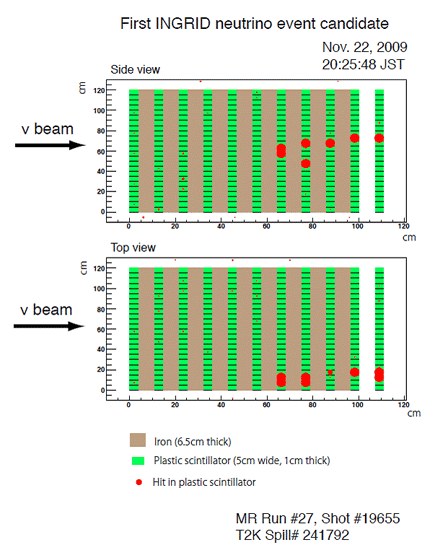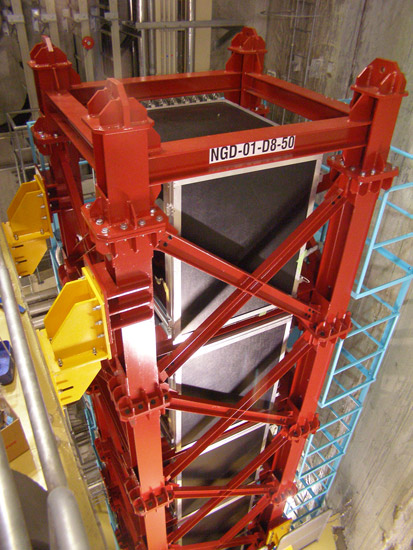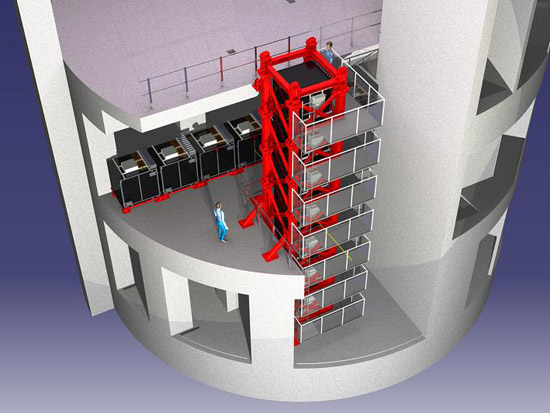| |
Physicists from the Japanese-led multi-national T2K neutrino
collaboration announced today that over the weekend they detected the
first events generated by their newly built neutrino beam at the J-PARC
accelerator laboratory in Tokai, Japan. Protons from the 30-GeV Main
Ring synchrotron were directed onto a carbon target, where their
collisions produced charged particles called pions. These pions
travelled through a helium-filled volume where they decayed to produce a
beam of the elusive particles called neutrinos. These neutrinos then
flew 200 metres through the earth to a sophisticated detector system
capable of making detailed measurements of their energy, direction, and
type. The data from the complex detector system is still be analysed,
but the physicists have seen at least 3 neutrino events, in line with
the expectation based on the current beam and detector performance.
Prof. Koichiro Nishikawa, director of the Institute for Particle and
Nuclear physics at the KEK laboratory and founder of the T2K
collaboration, said "The T2K experiment is about to reveal another
mystery of neutrinos. I would like to thank everyone who has been
supporting this experiment directly or indirectly and to thank our
excellent collaborators from all over the world for making it possible
to reach this stage of the experiment. All the people in T2K also owe a
big debt to the accelerator physicists who worked so hard to build and
commission the accelerators. And especially, I would like to thank
Japanese government and all of the foreign governments for giving us a
strong support and I would like to ask for continuing support. We are
ready to do our best to reveal the full mysteries of neutrinos."
This detection marks the beginning of the operational phase of
the T2K experiment, a ~500 physicist, 12 nation collaboration to measure
new properties of the ghostly neutrino. Prof. Atsuto Suzuki, Director
General of the KEK laboratory, said "Studies of neutrinos in the T2K
experiment are going to unveil unknown properties of neutrinos.
Researchers around the world must be jealous that once again neutrinos
seem to like to reveal new properties in Japan! Neutrino detection is
the first step toward it and I can hardly wait to see the experimental
results." Neutrinos interact only weakly with matter, and thus pass
effortlessly through the earth (and mostly through the detectors!).
Neutrinos exist in three types, called electron, muon, and tau; linked
by particle interactions to their more familiar charged cousins like the
electron. Measurements over the last few decades, notably by the Super-Kamiokande and KamLAND neutrino experiments in western Japan, have shown
that neutrinos possess the strange property of neutrino oscillations,
whereby one type of neutrino will turn into another as they propagate
through space. Neutrino oscillations, which require neutrinos to have
mass and therefore were not allowed in our previous theoretical
understanding of particle physics, probe new physical laws and are thus
of great interest in the study of the fundamental constituents of
matter. They may even be related to the mystery of why there is more
matter than anti-matter in the universe, and thus are the focus of
intense study worldwide. Dr. Takashi Kobayashi, Spokesperson of the T2K
experiment, said "The study of neutrino oscillations is one of our best
keys for really understanding the most fundamental laws of physics, and
this weekend's progress brings us one more step towards fully
understanding them."
Precision measurements of neutrino oscillations can be made using
artificial neutrino beams, as pioneered by the K2K neutrino experiment
where neutrinos from the KEK laboratory were detected using the vast
Super-Kamiokande neutrino detector near Toyama. T2K is a more powerful
and sophisticated version of the K2K experiment, with a more intense
neutrino beam derived from the newly-built Main Ring synchrotron at the
J-PARC accelerator laboratory. The beam was built by physicists from KEK
in cooperation with other Japanese institutions and with assistance from
the US, Canadian, UK and French T2K institutes. Prof. Chang Kee Jung, of
Stony Brook University, Stony Brook, New York, leader of the US T2K
project, said "I am somewhat stunned by this seemingly effortless
achievement considering the complexity of the machinery, the operation
and international nature of the project. This is a result of a strong
support from the Japanese government for basic science, which I hope
will continue, and hard work and ingenuity of all involved. I am excited
about more ground breaking findings from this experiment in the near
future". The beam is aimed once again at Super-Kamiokande, which has
been upgraded for this experiment with new electronics and software.
Prof. Yoichiro Suzuki, of ICRR Tokyo and Spokesperson of the Super-Kamiokande experiment, said "'This is a great step for T2K and we will
soon see the neutrino interactions in Super-K, 295km from JPARC, where
we have renovated all the front-end electronics and online systems for
the experiment." Before the neutrinos leave the J-PARC facility their
properties are determined by a sophisticated "near" detector, partly
based on a huge magnet donated from CERN where it had earlier been used
for neutrino experiments (and for the UA1 experiment, which won the
Nobel Prize for the discovery of the W and Z bosons which are the basis
of neutrino interactions), and it is this detector which caught the
first events. Prof. Dave Wark of Imperial College London and the
Rutherford Appleton Laboratory, the International Co-Spokesperson of
T2K, said "It was extremely satisfying to see the first events in the
detector. It has been the result of a lot of hard work by a large number
of people, and I think we will have a sake or two to celebrate and then
send a bottle along to CERN as I hear they need a few bottles as well."
Prof. Andre Rubbia of ETH Zurich, who led the effort to refurbish and bring the huge magnet from CERN" said "We are terribly excited to see the
first neutrinos from the beam! We came from far away to work at
thisunique facility. T2K is a clear example of nations world-wide
joining efforts to discover new fundamental properties of Nature".
The first neutrino events
were detected in a specialized detector, called
the INGRID, whose purpose is to determine the neutrino beam's direction
and profile. Prof. Tsuyoshi Nakaya of Kyoto University, who is leading
the effort to build the near detectors, said "We found the first
neutrino event in real time during the neutrino beam running. The
detection of this event stands on huge efforts by many T2K colleagues
all over the world. I would like to add special thanks to many young
researchers who worked very hard for a long time, especially the Kyoto
Ph. D. students who found the events analyzing the data online with much
pressure from senior researchers". Dr. Marco Zito from the CEA/Saclay
Laboratory in Paris, who leads the CEA French effort on the experiment which
helped build the INGRID, added "It is a great day for neutrino physics!
This is the first of a new generation of international neutrino
oscillation facilities to come to life. We are all looking forward to
the first T2K run and its harvest of fundamental physics results. In
particular, the near detector has been built using innovative
technologies that will provide detailed information on neutrino
interactions. This detector complex will allow us to make precision
measurements and probably exciting discoveries". Further tests of the
T2K neutrino beam are scheduled for December, and the experiment plans
to begin production running in mid-January. Another major milestone
should be observed soon after -- the first observation of a neutrino
event from the T2K beam in the Super-Kamiokande experiment. Running will
continue until the summer, by which time the experiment hopes to have
made the most sensitive search yet achieved for a so-far-unobserved
critical neutrino oscillation mode dominated by oscillations between all
three types of neutrinos. In the coming years this search will be
improved even further, with the hope that the 3-mode oscillation will be
observed, allowing measurements to begin comparing the oscillations of
neutrinos and anti-neutrinos, probing the physics of anti-matter in the
neutrino sector. Prof. Jean-Michel Poutissou, head of the Canadian
effort on the experiment, said "I am delighted that a 6 years effort by
a Canadian group of 50 scientists working in unison with more than 400
Japanese and foreign partners has come to this spectacular early success
of seeing a first neutrino event in the neutrino facility just assembled
at J-PARC. I sense and very much appreciate the excitement of our young
students and post doctoral fellows who have been given the chance to
participate in this fore front international research. This is the best
training they can possibly get as future leaders of our communities in a
global environment".
Background: The T2K collaboration consists of 508 physicists from 62
institutes in 12 countries (Japan, South Korea, Canada, the United
States, the United Kingdom, France, Spain, Italy, Switzerland, Germany,
Poland, and Russia). The experiment consists of a new neutrino beam
using the recently constructed 30 GeV synchrotron at the J-PARC
laboratory in Tokai, Japan, a set of near detectors constructed 280m
from the neutrino production target, and the Super-Kamiokande detector
in western Japan.
The complete list of institutions can be found at:
http://neutrino.kek.jp/t2k/T2KInstitutions.pdf
| |
[ Related Web Site ] |
J-PARC
KEK
JAEA |
| [ Media Contact ] |
Youhei Morita,
Head of Public Relations Office, KEK
tel. +81-29-879-6047 |
 |
Fig1 : The first neutrino interaction event detected in one of the 14 modules of the T2K neutrino detector called the INGRID. A neutrino enters from the left and interacts within the detector, producing charged particles whose tracks are shown as the red circles. Each of the green cells in this figure is a detector for charged particles, and the size of the red circles indicates the size of the observed signal in that cell. |
 |
Fig2 : A photograph of the T2K INGRID neutrino detector. Each of the black cubes is a module of the INGRID. |
 |
Fig3 : A schematic view of the T2K INGRID neutrino detector. Out of 14 modules, 7 modules are in a vertical line and 7 in a horizontal. The first neutrino event was observed in the bottom-most module. |
|

